TOYOTA AVENSIS 2017 Owners Manual (in English)
Manufacturer: TOYOTA, Model Year: 2017, Model line: AVENSIS, Model: TOYOTA AVENSIS 2017Pages: 661, PDF Size: 39.92 MB
Page 481 of 661
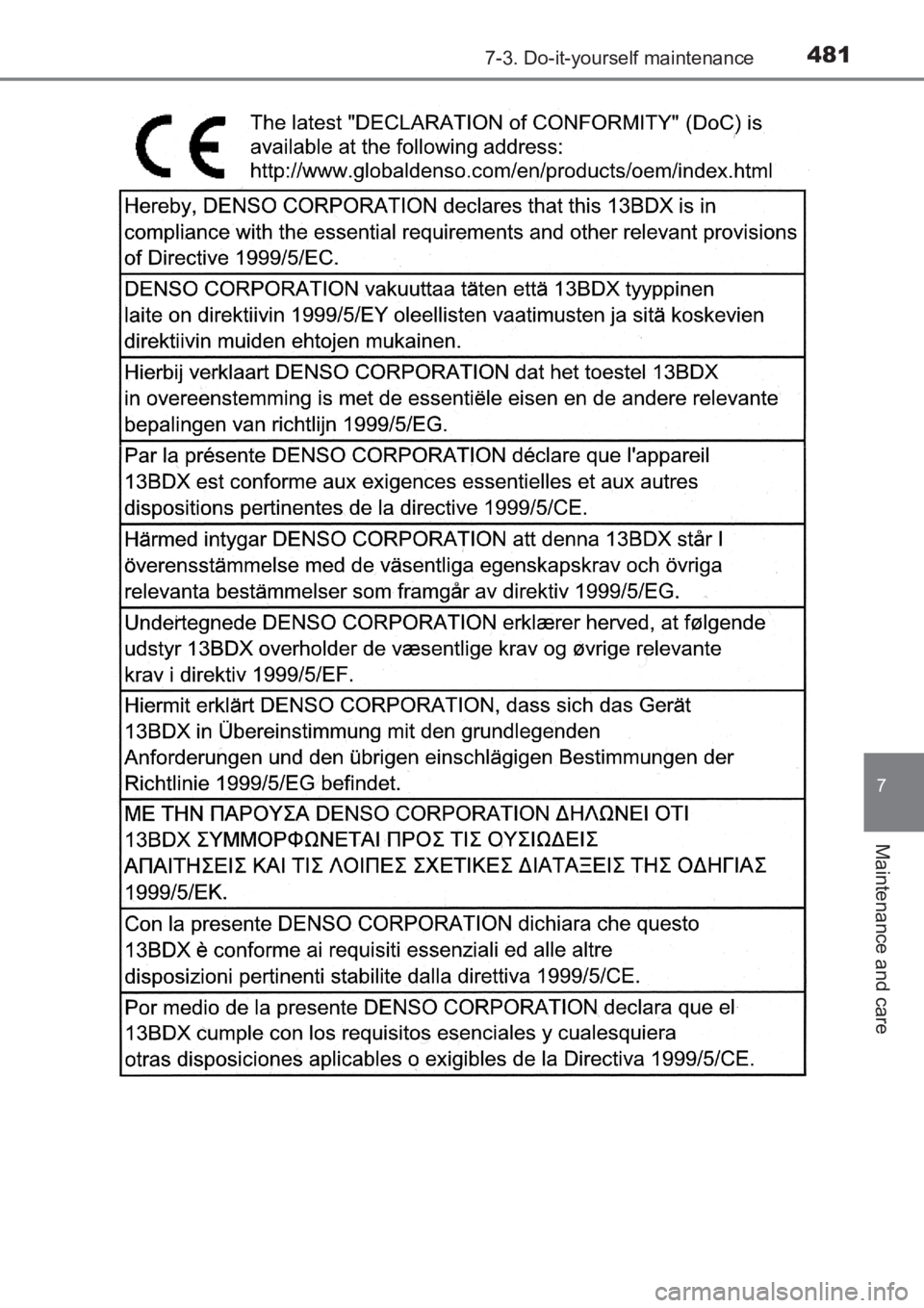
4817-3. Do-it-yourself maintenance
AVENSIS_OM_OM20C66E_(EE)
7
Maintenance and care
AVENSIS_OM_OM20C66E_(EE).book Page 481 Wednesday, June 15, 2016 4:07 PM
Page 482 of 661
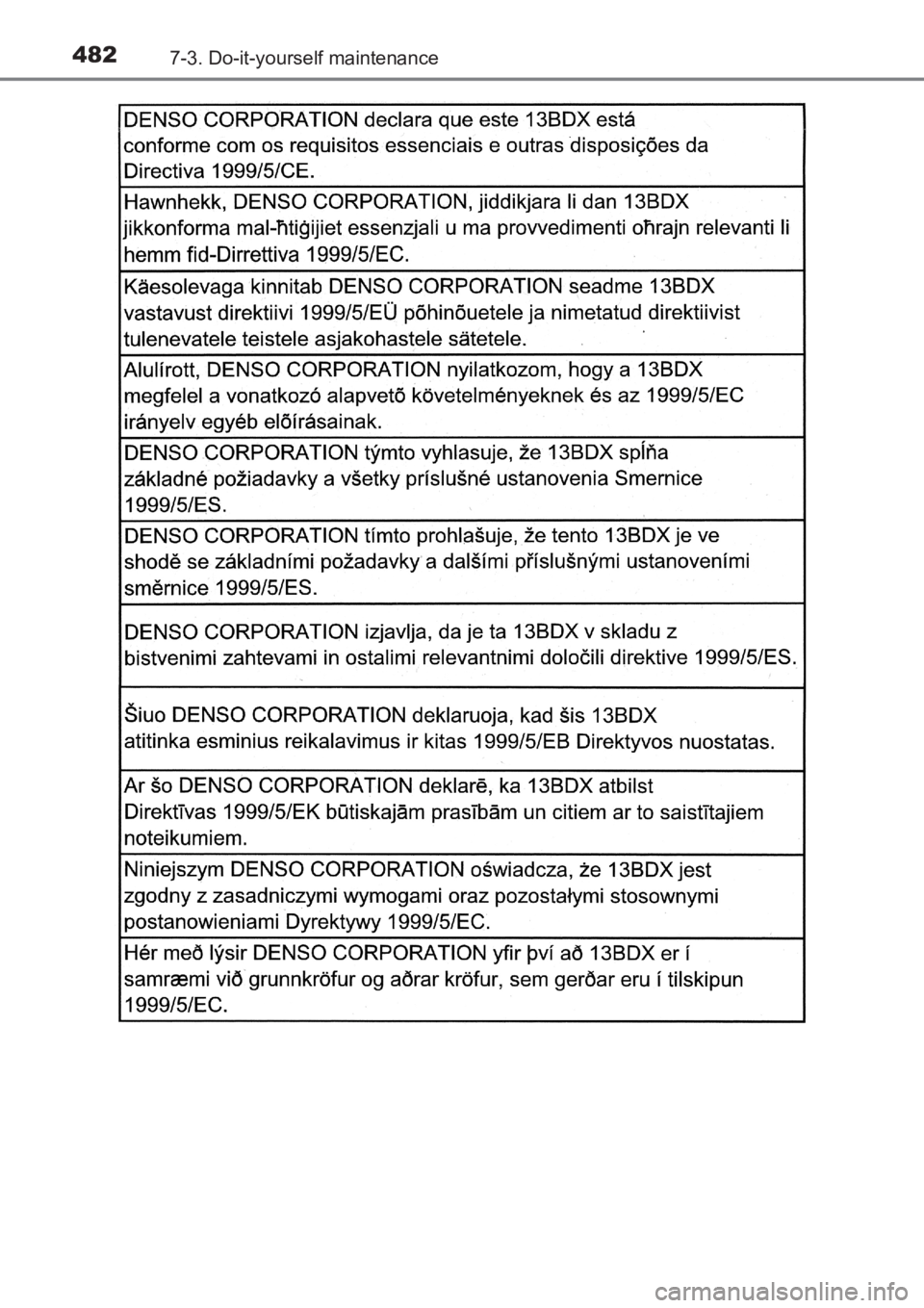
4827-3. Do-it-yourself maintenance
AVENSIS_OM_OM20C66E_(EE)
AVENSIS_OM_OM20C66E_(EE).book Page 482 Wednesday, June 15, 2016 4:07 PM
Page 483 of 661

4837-3. Do-it-yourself maintenance
AVENSIS_OM_OM20C66E_(EE)
7
Maintenance and care
AVENSIS_OM_OM20C66E_(EE).book Page 483 Wednesday, June 15, 2016 4:07 PM
Page 484 of 661
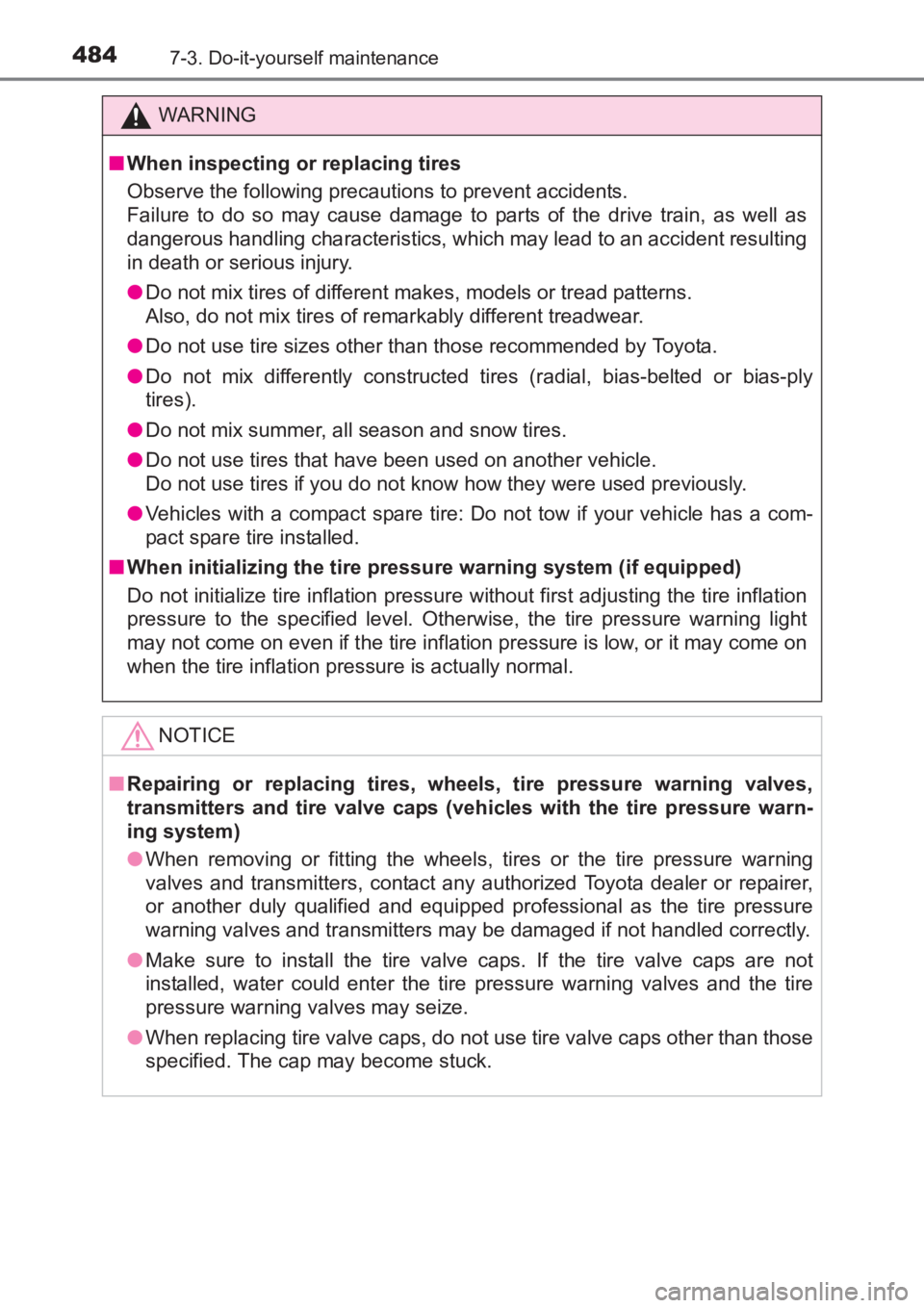
4847-3. Do-it-yourself maintenance
AVENSIS_OM_OM20C66E_(EE)
WARNING
■ When inspecting or replacing tires
Observe the following precautions to prevent accidents.
Failure to do so may cause damage to parts of the drive train, as well as
dangerous handling characteristics, which may lead to an accident resulting
in death or serious injury.
●Do not mix tires of different makes, models or tread patterns.
Also, do not mix tires of remarkably different treadwear.
● Do not use tire sizes other than those recommended by Toyota.
● Do not mix differently constructed tires (radial, bias-belted or bias-ply
tires).
● Do not mix summer, all season and snow tires.
● Do not use tires that have been used on another vehicle.
Do not use tires if you do not know how they were used previously.
● Vehicles with a compact spare tire: Do not tow if your vehicle has a com-
pact spare tire installed.
■ When initializing the tire pressu re warning system (if equipped)
Do not initialize tire inflation pressure without first adjusting the tire inflation
pressure to the specified level. Otherwise, the tire pressure warning light
may not come on even if the tire inflation pressure is low, or it may come on
when the tire inflation pressure is actually normal.
NOTICE
■Repairing or replacing tires, wheels, tire pressure warning valves,
transmitters and tire valve caps (vehicles with the tire pressure warn-
ing system)
●When removing or fitting the wheels, ti res or the tire pressure warning
valves and transmitters, contact any authorized Toyota dealer or repairer,
or another duly qualified and equipped professional as the tire pressure
warning valves and transmitters may be damaged if not handled correctly.
● Make sure to install the tire valve caps. If the tire valve caps are not
installed, water could enter the tire pressure warning valves and the tire
pressure warning valves may seize.
● When replacing tire valve caps, do not use tire valve caps other than those
specified. The cap may become stuck.
AVENSIS_OM_OM20C66E_(EE).book Page 484 Wednesday, June 15, 20 16 4:07 PM
Page 485 of 661
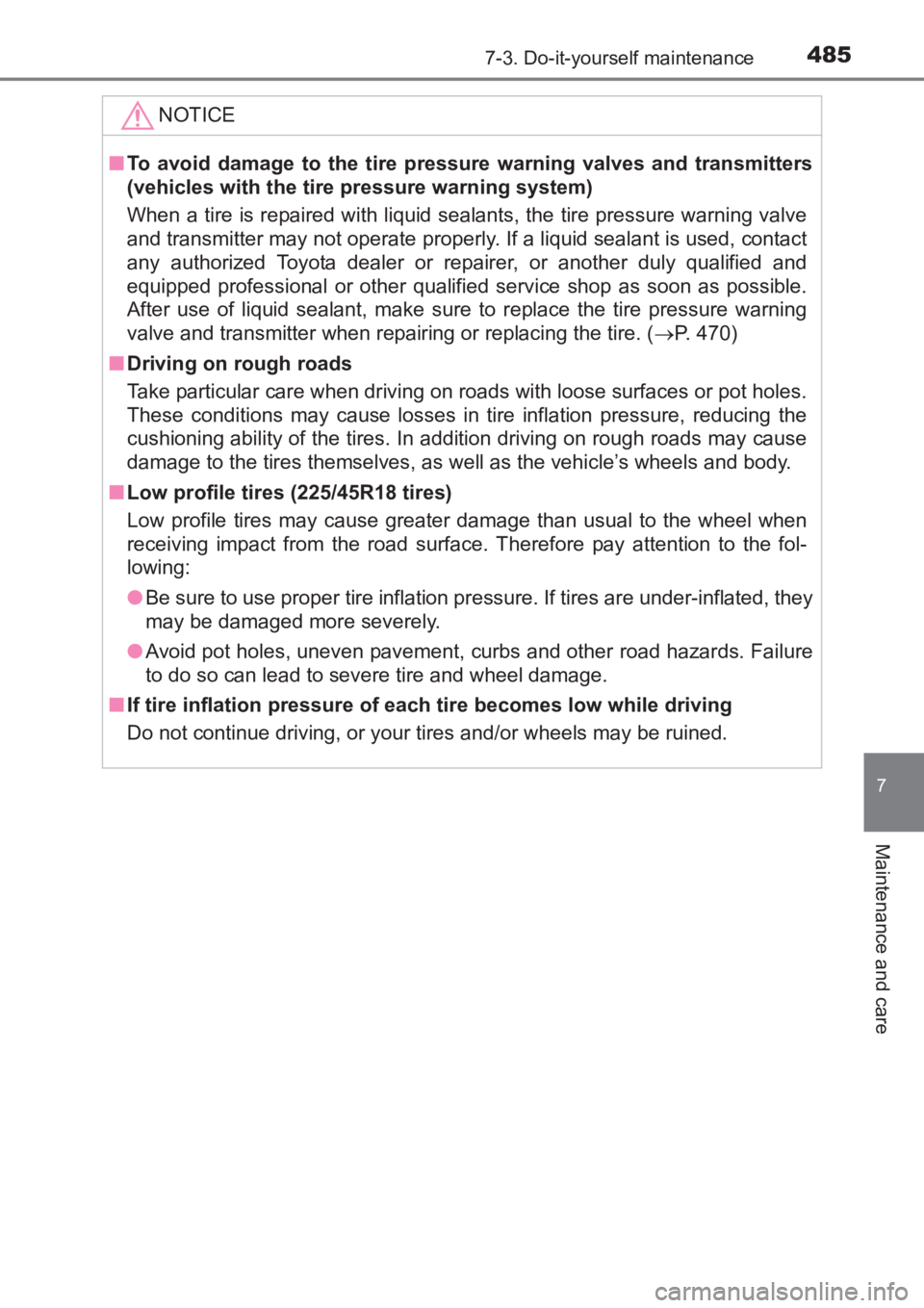
4857-3. Do-it-yourself maintenance
AVENSIS_OM_OM20C66E_(EE)
7
Maintenance and care
NOTICE
■To avoid damage to the tire pressure warning valves and transmitters
(vehicles with the tire pressure warning system)
When a tire is repaired with liquid sealants, the tire pressure warning valve
and transmitter may not operate properly. If a liquid sealant is used, contact
any authorized Toyota dealer or repairer, or another duly qualified and
equipped professional or other qualified service shop as soon as possible.
After use of liquid sealant, make sure to replace the tire pressure warning
valve and transmitter when repairing or replacing the tire. ( →P. 470)
■ Driving on rough roads
Take particular care when driving on roads with loose surfaces or pot holes.
These conditions may cause losses in tire inflation pressure, reducing the
cushioning ability of the tires. In addition driving on rough roads may cause
damage to the tires themselves, as well as the vehicle’s wheels and body.
■ Low profile tires (225/45R18 tires)
Low profile tires may cause greater damage than usual to the wheel when
receiving impact from the road surface. Therefore pay attention to the fol-
lowing:
●Be sure to use proper tire inflation pressure. If tires are under-inflated, they
may be damaged more severely.
● Avoid pot holes, uneven pavement, curbs and other road hazards. Failure
to do so can lead to severe tire and wheel damage.
■ If tire inflation pressure of each tire becomes low while driving
Do not continue driving, or your tires and/or wheels may be ruined.
AVENSIS_OM_OM20C66E_(EE).book Page 485 Wednesday, June 15, 20 16 4:07 PM
Page 486 of 661
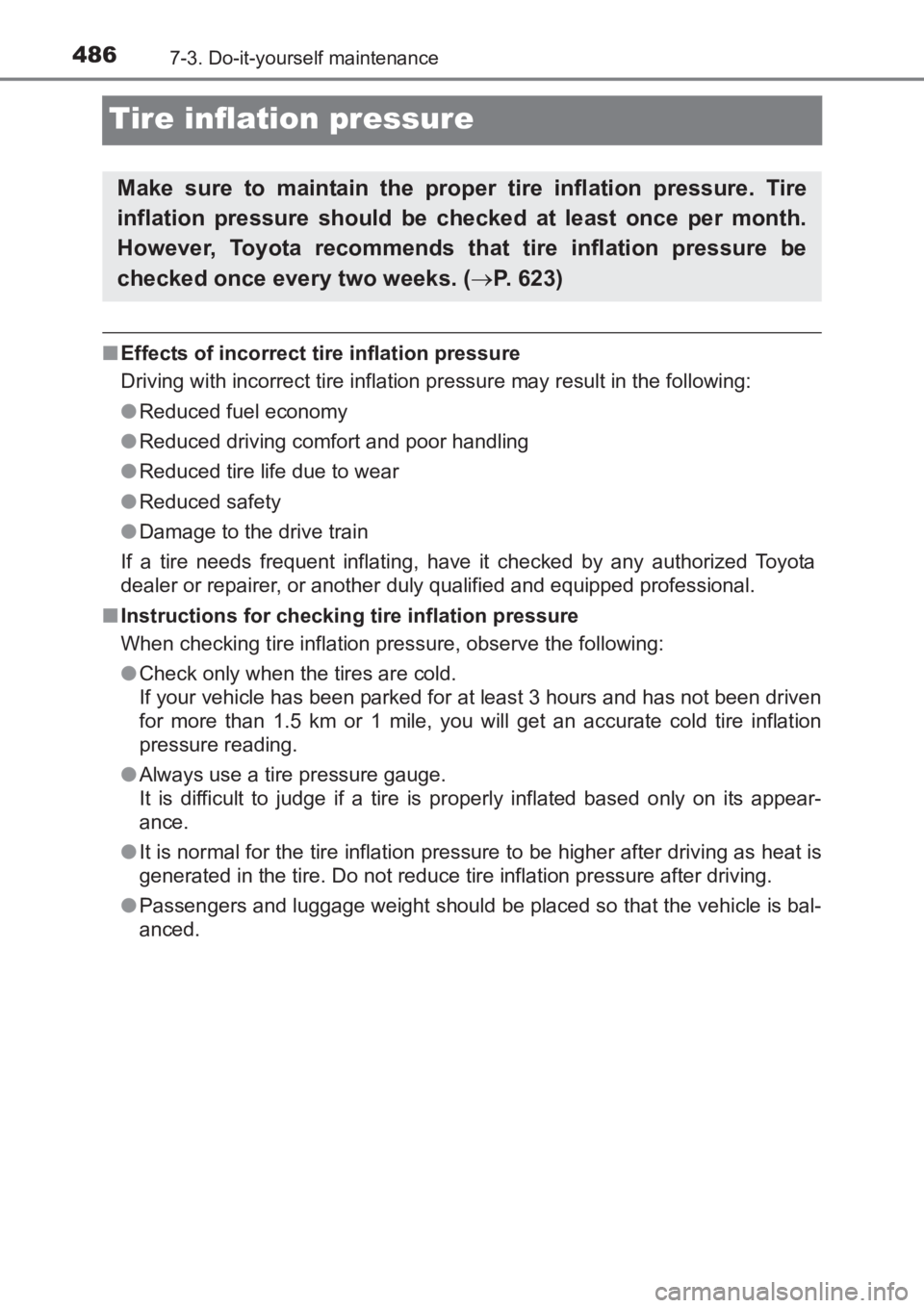
4867-3. Do-it-yourself maintenance
AVENSIS_OM_OM20C66E_(EE)
Tire inflation pressure
■Effects of incorrect tire inflation pressure
Driving with incorrect tire inflation pressure may result in the following:
●Reduced fuel economy
● Reduced driving comfort and poor handling
● Reduced tire life due to wear
● Reduced safety
● Damage to the drive train
If a tire needs frequent inflating, have it checked by any authorized Toyota
dealer or repairer, or another duly qualified and equipped professional.
■ Instructions for checking tire inflation pressure
When checking tire inflation pressure, observe the following:
● Check only when the tires are cold.
If your vehicle has been parked for at least 3 hours and has not been driven
for more than 1.5 km or 1 mile, you will get an accurate cold tire inflation
pressure reading.
● Always use a tire pressure gauge.
It is difficult to judge if a tire is properly inflated based only on its appear-
ance.
● It is normal for the tire inflation pressure to be higher after driving as heat is
generated in the tire. Do not reduce tire inflation pressure after driving.
● Passengers and luggage weight should be placed so that the vehicle is bal-
anced.
Make sure to maintain the proper tire inflation pressure. Tire
inflation pressure should be checked at least once per month.
However, Toyota recommends that tire inflation pressure be
checked once every two weeks. ( →P. 623)
AVENSIS_OM_OM20C66E_(EE).book Page 486 Wednesday, June 15, 20 16 4:07 PM
Page 487 of 661
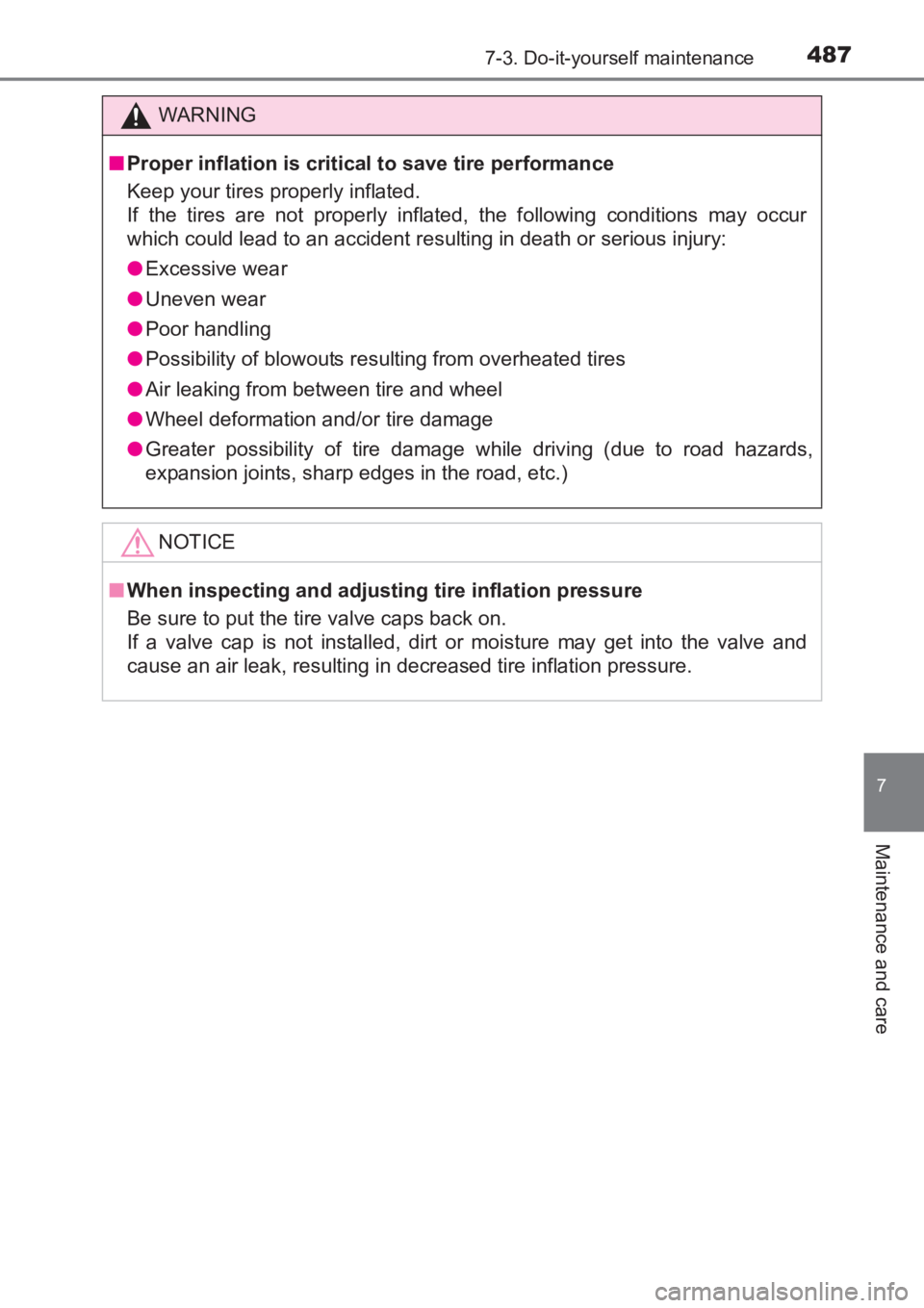
4877-3. Do-it-yourself maintenance
AVENSIS_OM_OM20C66E_(EE)
7
Maintenance and care
WARNING
■ Proper inflation is critical to save tire performance
Keep your tires properly inflated.
If the tires are not properly inflated, the following conditions may occur
which could lead to an accident resulting in death or serious injury:
●Excessive wear
● Uneven wear
● Poor handling
● Possibility of blowouts resulting from overheated tires
● Air leaking from between tire and wheel
● Wheel deformation and/or tire damage
● Greater possibility of tire damage while driving (due to road hazards,
expansion joints, sharp edges in the road, etc.)
NOTICE
■ When inspecting and adjusting tire inflation pressure
Be sure to put the tire valve caps back on.
If a valve cap is not installed, dirt or moisture may get into the valve and
cause an air leak, resulting in decreased tire inflation pressure.
AVENSIS_OM_OM20C66E_(EE).book Page 487 Wednesday, June 15, 20 16 4:07 PM
Page 488 of 661
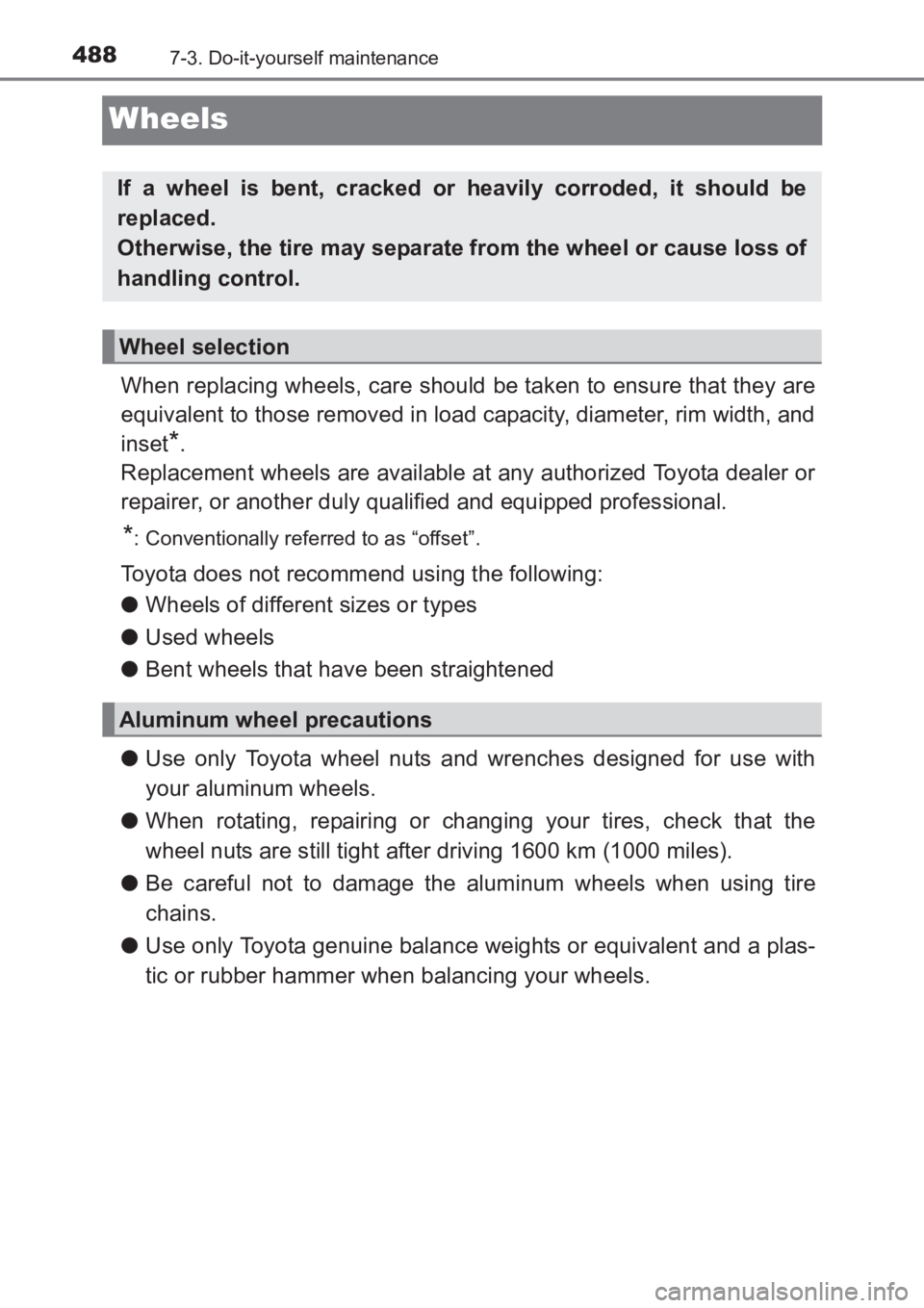
4887-3. Do-it-yourself maintenance
AVENSIS_OM_OM20C66E_(EE)
Wheels
When replacing wheels, care should be taken to ensure that they are
equivalent to those removed in load capacity, diameter, rim width, and
inset
*.
Replacement wheels are available at any authorized Toyota dealer or
repairer, or another duly qualified and equipped professional.
*: Conventionally referred to as “offset”.
Toyota does not recommend using the following:
● Wheels of different sizes or types
● Used wheels
● Bent wheels that have been straightened
● Use only Toyota wheel nuts and wrenches designed for use with
your aluminum wheels.
● When rotating, repairing or changing your tires, check that the
wheel nuts are still tight after driving 1600 km (1000 miles).
● Be careful not to damage the aluminum wheels when using tire
chains.
● Use only Toyota genuine balance weights or equivalent and a plas-
tic or rubber hammer when balancing your wheels.
If a wheel is bent, cracked or heavily corroded, it should be
replaced.
Otherwise, the tire may separate from the wheel or cause loss of
handling control.
Wheel selection
Aluminum wheel precautions
AVENSIS_OM_OM20C66E_(EE).book Page 488 Wednesday, June 15, 20 16 4:07 PM
Page 489 of 661
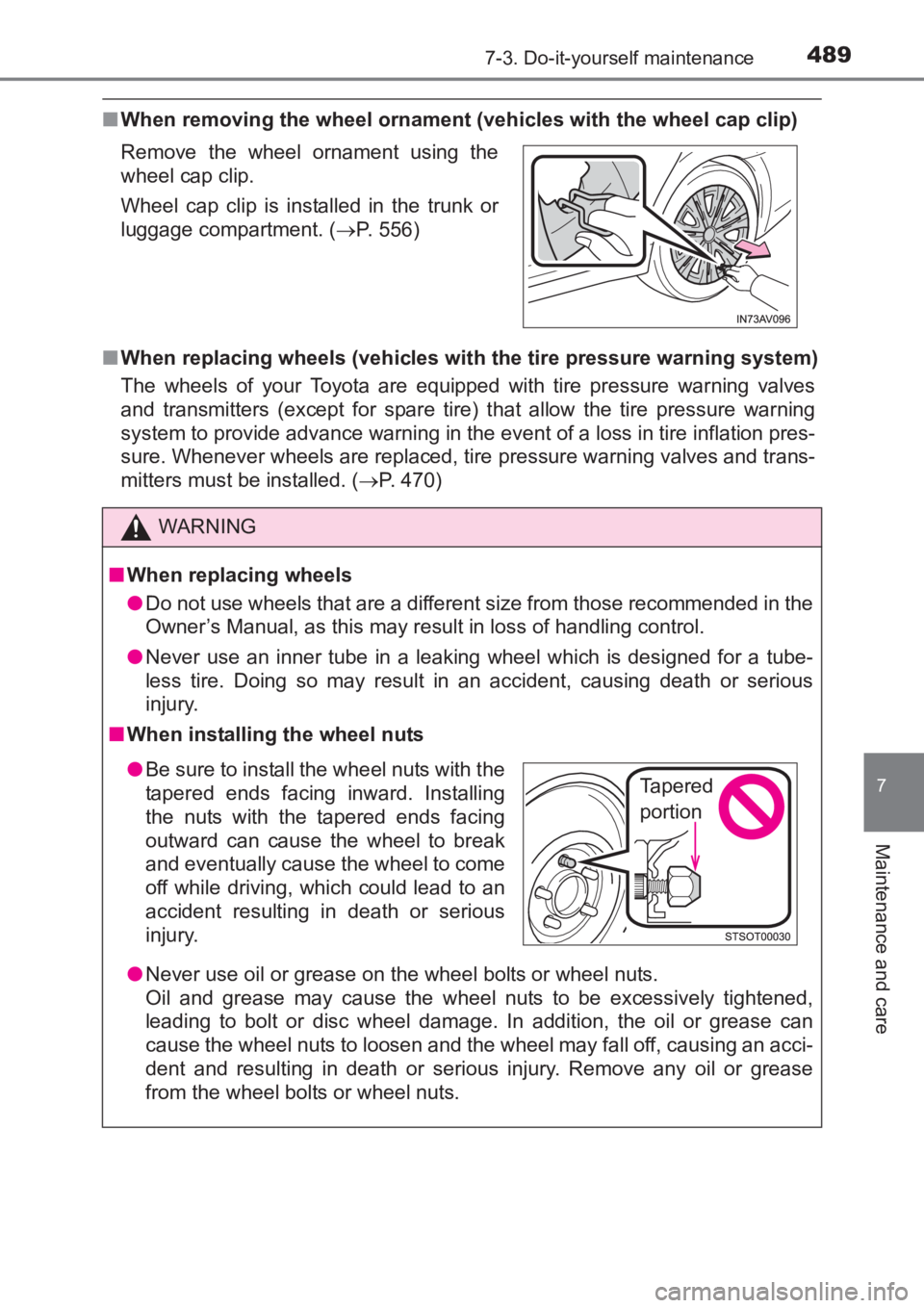
4897-3. Do-it-yourself maintenance
AVENSIS_OM_OM20C66E_(EE)
7
Maintenance and care
■When removing the wheel ornament (vehicles with the wheel cap clip)
■ When replacing wheels (vehicles with the tire pressure warning system)
The wheels of your Toyota are equipped with tire pressure warning valves
and transmitters (except for spare tire) t hat allow the tire pressure warning
system to provide advance warning in the event of a loss in tire inflation pres-
sure. Whenever wheels are replaced, tire pressure warning valves and trans-
mitters must be installed. ( →P. 470)
Remove the wheel ornament using the
wheel cap clip.
Wheel cap clip is installed in the trunk or
luggage compartment. (
→P. 556)
WARNING
■ When replacing wheels
●Do not use wheels that are a different size from those recommended in the
Owner’s Manual, as this may result in loss of handling control.
● Never use an inner tube in a leaking wheel which is designed for a tube-
less tire. Doing so may result in an accident, causing death or serious
injury.
■ When installing the wheel nuts
●Never use oil or grease on the wheel bolts or wheel nuts.
Oil and grease may cause the wheel nuts to be excessively tightened,
leading to bolt or disc wheel damage. In addition, the oil or grease can
cause the wheel nuts to loosen and the wheel may fall off, causing an acci-
dent and resulting in death or serious injury. Remove any oil or grease
from the wheel bolts or wheel nuts.
● Be sure to install the wheel nuts with the
tapered ends facing inward. Installing
the nuts with the tapered ends facing
outward can cause the wheel to break
and eventually cause the wheel to come
off while driving, which could lead to an
accident resulting in death or serious
injury.Tapered
portion
AVENSIS_OM_OM20C66E_(EE).book Page 489 Wednesday, June 15, 20 16 4:07 PM
Page 490 of 661
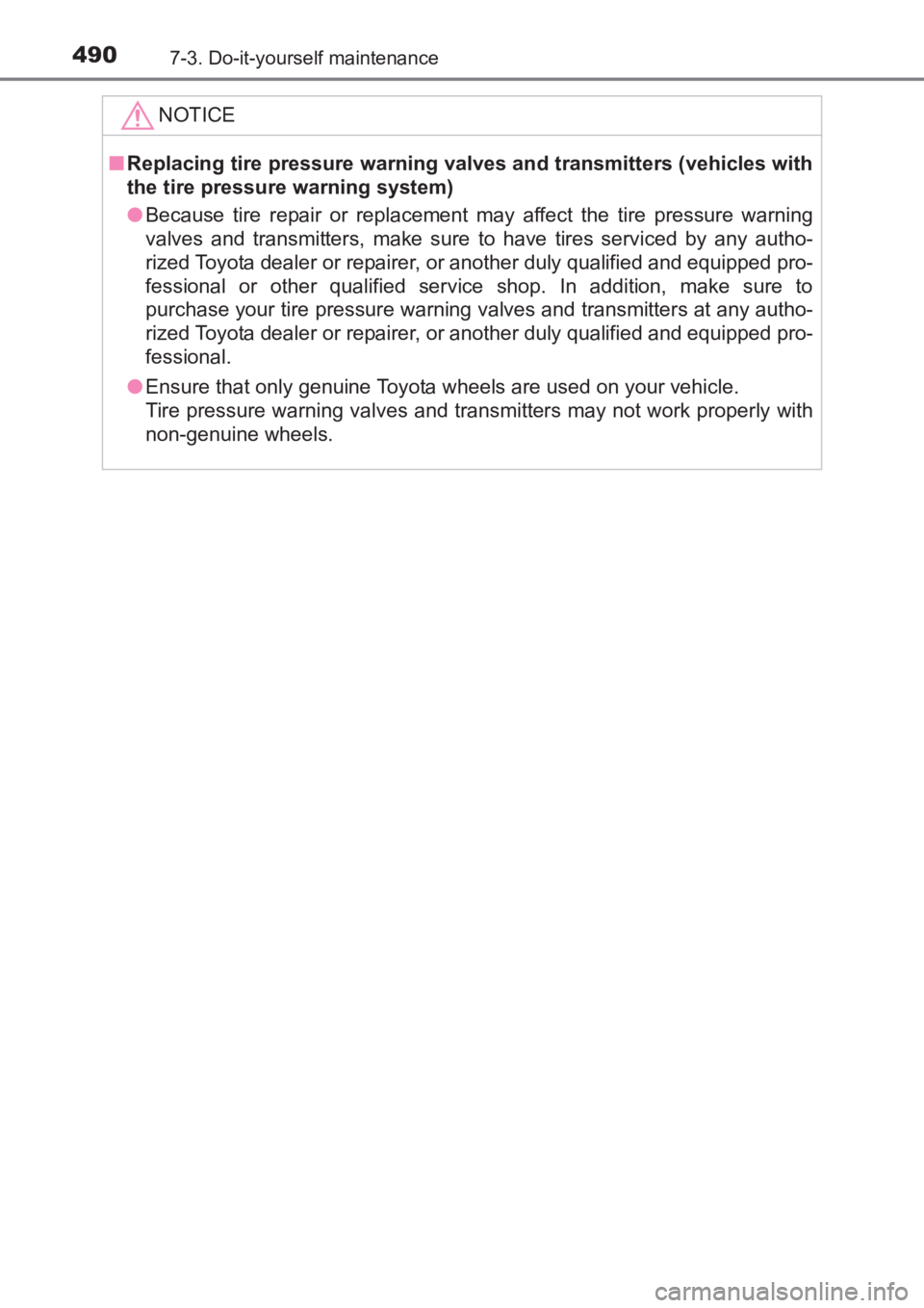
4907-3. Do-it-yourself maintenance
AVENSIS_OM_OM20C66E_(EE)NOTICE
■
Replacing tire pressure warning valves and transmitters (vehicles with
the tire pressure warning system)
●Because tire repair or replacement may affect the tire pressure warning
valves and transmitters, make sure to have tires serviced by any autho-
rized Toyota dealer or repairer, or another duly qualified and equipped pro-
fessional or other qualified service shop. In addition, make sure to
purchase your tire pressure warning valves and transmitters at any autho-
rized Toyota dealer or repairer, or another duly qualified and equipped pro-
fessional.
● Ensure that only genuine Toyota wheels are used on your vehicle.
Tire pressure warning valves and transmitters may not work properly with
non-genuine wheels.
AVENSIS_OM_OM20C66E_(EE).book Page 490 Wednesday, June 15, 20 16 4:07 PM